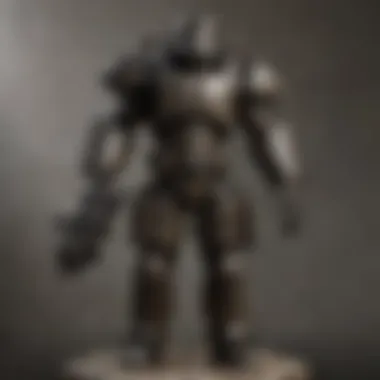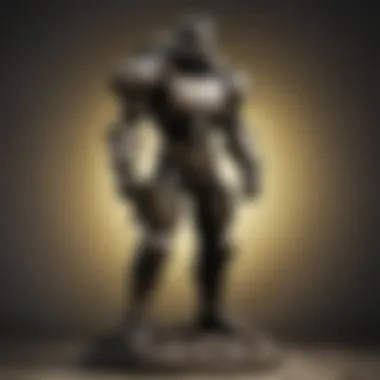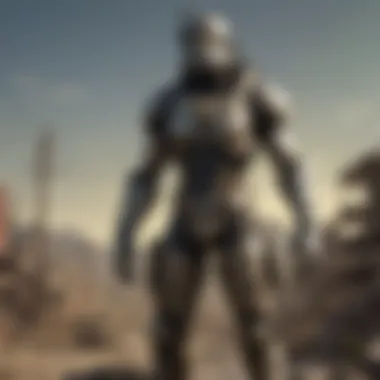The Fallout Statue: Symbol of Post-Apocalyptic Culture


Intro
When it comes to the world of video games, there’s often more than meets the eye. The Fallout series has carved out a niche that goes beyond mere entertainment, entwining itself with deeper themes of society, survival, and identity in a post-apocalyptic setting. One emblematic representation of this intricate world is the Fallout statue, which serves as a physical manifestation of the series' cultural significance. This article dives into the multifaceted existence of the Fallout statue, exploring how it stands not just as artwork but as a critical piece in the larger puzzle of gaming culture and community engagement.
Lore Insights
Overview of the Fallout Universe
To understand the Fallout statue's significance, one must first grasp the broader Fallout universe. This world is defined by a stark contrast between the optimism of mid-20th-century Americana and the grim realities of a nuclear war that left much of humanity in ruins. Players navigate through regions like the Wasteland, encountering mutated creatures, remnants of corporations, and a myriad of factions vying for control and survival.
Key Historical Events in the Fallout Timeline
Several events crafted the narrative foundation that Fallout players know today:
- The Great War (2077): A nuclear conflict that obliterated much of the world—this is where Fallout's essential lore is rooted.
- The Rise of the Vaults: Government-sanctioned shelters designed to protect citizens from atomic fallout.
- The Emergence of Factions: Groups like the Brotherhood of Steel and the Institute shape interactions within the game.
By weaving these events together, the statue embodies elements crucial to the overarching narrative of resilience and fragmentation.
Deep Dive into the Backstory of Major Factions and Characters
One can’t discuss the Fallout series without acknowledging the diverse factions and the characters that inhabit this fractured landscape. Each faction—from the benevolent Minutemen to the ruthless raiders—provides a unique perspective on survival. The statue echoes these dynamics, reflecting the cultural climate of the Fallout universe. For example, the NCR (New California Republic) strives for order amidst chaos, while the Enclave signifies a more authoritarian approach to survival. The statue often symbolizes the conflicting ideologies held by these groups and exemplifies their complex interactions.
"In the Fallout universe, survival is more than a goal; it’s a legacy shared through lore and community engagement."
The statue encapsulates the essence of these thematic struggles, presenting a narrative rich in choices, morality, and personal development.
Gameplay Tips and Strategies
A Beginner's Guide to Playing Fallout Games
For those new to the franchise, starting can feel overwhelming. Here are some tips to ease you into the experience:
- Understand the S.P.E.C.I.A.L. System: This framework defines character statistics and personal strengths. It’s vital for effective gameplay decisions.
- Explore: The world is vast, and hidden gems enhance the experience. Interactions with NPCs and finding unique items can alter your journey.
Weapon and Armor Recommendations
Weapons in Fallout range from the conventional to the downright bizarre. A few noteworthy mentions include:
- The Plasma Rifle: It packs a punch against both enemies and environmental threats.
- Leather Armor: Basic yet effective, offering decent protection in the early stages.
Tips for Efficient Resource Management
Resources can dwindle faster than you think. Here’s how to keep your inventory in check:
- Prioritize Inventory Space: Learn what items you actually need; keep crafting materials but ditch all low-value items.
- Use Workshops Wisely: They allow for crafting and modifying gear, making your loot more worthwhile.
Character Analysis
Detailed Profiles of Iconic Characters
The Fallout series boasts a cast of well-developed characters whose arcs often mirror the narrative complexity of the universe. Icons like Vault Boy exemplify optimism while also underlining the absurdity of nuclear fallout—he's a direct visual representation of the game’s themes. Another notable character, Ellie Perkins, showcases the humanistic side in a world filled with cynicism and brutality.
Relationships Between Characters in the Fallout Series
Human interactions are often what make or break a game. The Fallout series captures a complex web of relationships, from friendships to betrayals. The Courier in Fallout: New Vegas experiences shifting allegiances, wrestling with moral choices that influence the outcome.
Character Development and Evolution Across Games
With each new installment, character development has taken center stage—showing players the potential for growth or decay in both individuals and factions. This evolution arguably drives engagement, allowing for a more personalized gaming experience.


News and Updates
Latest Announcements from Game Developers
Keeping up with the latest from the developers can provide insights into future game updates and expansions. Bethesda frequently holds events showcasing what's next for the Fallout franchise.
Patch Notes and Upcoming Releases
Stay tuned for patch notes that can significantly affect gameplay mechanics or balance. Recent ones have improved multiplayer integration and added new quests, keeping the experience fresh.
Community Events and Tournaments
With a passionate community, events regularly pop up that not only enhance the gaming experience but also promote unity among fans. Reddit and Facebook groups often discuss these upcoming gatherings, ensuring players are in the loop.
Fan Theories and Speculations
Popular Fan Theories About the Fallout Universe
Fans have generated numerous theories that add depth to the lore. Some speculate about the True Ending of Fallout 3, while others ponder the fates of certain factions in future installments.
Discussion on Unresolved Plot Points
The series has always left players with more questions than answers. The tale of The Vaults still leads many to wonder what’s beyond their design.
Predictions for Future Installments in the Series
What’s next for Fallout? There are endless discussions in forums, with many hopeful for a clear return to a more narrative-driven gameplay style.
This article, through its various sections, aims to provide insight into how the Fallout statue symbolizes a larger cultural narrative surrounding not just the game but also its community and impact on modern storytelling.
Prelims to the Fallout Statue
The Fallout statue stands as a towering presence in the discourse around post-apocalyptic culture. This remarkable piece of art transcends mere decoration; it embodies the spirit of survival, humor, and resilience that defines the Fallout universe. Fans of the game often cite this statue as more than a collectible but as a symbol of their connection to a sprawling narrative that blends bleakness with optimism.
In exploring the nuances of the Fallout statue, we uncover not only its aesthetic values but also the historical nuances that birthed it. Every crack and crevice of this statue encapsulates a story about a world ravaged by disaster yet imbued with hope. Hence, it is imperative to delve into the rich contexts surrounding the statue's creation and its resonating purpose within the gaming community.
In the following sections, we will unravel its historical context and development, shedding light on why this statue transformed from a simple artistic endeavor to a cultural icon. Furthermore, we will navigate through its purpose and significance within both the immersive experience of the games and the broader landscape of gaming culture at large. This examination will not only offer readers an understanding of the statue itself but also highlight its role as an emblematic representation of post-apocalyptic society, reminding us of the narratives that shape our collective gaming experience.
Historical Context and Development
The Fallout statue did not emerge in a vacuum. Its roots can be traced back to the game series that has captured the imaginations of millions since its inception in the 1990s. The Fallout universe, which often reflects on human folly and societal collapse, draws inspiration from mid-century aesthetics of the Cold War era. As such, the statue is a marvelous fusion of retro-futurism and grim reality, presenting a visual narrative rich with cultural significance.
Initially conceived as a promotional piece, the statue was first revealed during the E3 gaming conferences, capturing the attention of fans and critics alike. The reception was overwhelmingly positive, prompting its creators to take notice of its potential as more than just merchandise. The statue soon graced conventions and events, becoming a recognizable fixture among Fallout enthusiasts, serving as a gathering point for fans to bond over their shared passion.
As gaming evolved, so too did the appreciation for art and artifacts that tell stories. This statue, built from high-quality materials, reflects a dedication to craftsmanship that resonates well with the high standards of modern players and collectors. Given the ever-growing desire for tangible connections to game universes, the Fallout statue’s journey from an initial marketing tool to a beloved symbol illustrates the undue relevance of physical representations in digital realms.
Purpose and Significance
At its core, the Fallout statue serves several pivotal purposes that extend beyond mere aesthetics. Firstly, it acts as a cultural anchor for fans, offering a tangible piece of the game world that they can keep in their own homes. Visual symbols often elicit a strong connection to the narratives from which they spring, much like a beloved character or a memorable quest.
Moreover, the statue embodies themes central to the Fallout narrative: post-apocalyptic survival, the pitfalls of human nature, and ultimately, the spirit of rebuilding. This multidimensional purpose invites players to engage with the game on a deeper level, uniting them not only in enjoyment but also in shared interpretations of the series’ broader commentary on society.
Additionally, it fosters community. When fans gather around the statue at conventions, they don’t just stand in admiration but engage in discussions about lost worlds and imagined futures. Such interactions are crucial to the community aspect of gaming, further binding individuals through a common love for the Fallout franchise.
“A statue is not merely stone; it’s the laughter and sorrow of a community encapsulated in time.”
Design Elements of the Fallout Statue
The design elements of the Fallout statue play a pivotal role in shaping its identity and cultural resonance within the gaming community. By examining what composes this piece of art—its materials, craftsmanship, and the deeper symbolism interwoven throughout—one can appreciate not just its aesthetic appeal but also its narrative significance in the Fallout universe. Such analysis underscores how detailed artistic decisions can evoke emotions and feelings that transcend the surface, allowing for connections amongst players and fans alike.


Materials and Craftsmanship
The materials and craftsmanship of the Fallout statue are fundamental to its presence as a cultural artifact. Made typically from durable resin and sometimes adorned with metallic finishes, the statue is designed to withstand the test of time, both physically and symbolically. This choice mirrors the themes of resilience and survival intrinsic to the Fallout series. The statue's surface might exhibit a weathered look, further emphasizing a post-apocalyptic aesthetic, making it visually compelling.
Craftsmanship reflects not merely technical skills but a passion for the lore it represents. Each curve and contour is meticulously crafted, embodying elements that fans come to recognize. Take, for example, the famous Pip-Boy. Its portrayal not only captivates but offers a tangible connection to the player's journey—symbolizing hope, adventure, and the thrill of the unknown. The attention to detail stands out, creating a piece that is more than mere decoration; it tells a story.
Symbolism within the Fallout Universe
The symbolism found within the Fallout statue is rich and layered, resonating deeply with the themes of the series. For instance, the character's pose often symbolizes defiance against adversity, holding aloft a weapon or tool that represents humanity's fight for survival. This act stands as a metaphor for the player's journey through desolation—in a world where choices lead to consequences, and actions define legacies.
Moreover, colors used in the statue's design are not chosen lightly. For instance, a palette often dominated by muted tones signifies decay and the ravages of time, while splashes of brighter colors evoke the remnants of the old world—an allusion to hope amidst despair.
"The Fallout statue can be seen as a beacon of nostalgia, capturing the essence of a world reborn from the ashes of its past."
Even the inscriptions that might accompany the statue speak volumes about sacrifice and resilience, echoing the narratives that players encounter throughout the game. This deep-seated symbolism enhances fan engagement, prompting players to reflect on their experiences and choices within the Fallout universe.
In summary, the design elements of the Fallout statue not only blend artistry with craftsmanship, but they also encapsulate profound narrative themes. The materials used tell of endurance, while the symbolic representations connect fans to the larger mythology of the game, ultimately establishing the statue as an enduring icon within the realm of post-apocalyptic culture.
Cultural Impact of the Fallout Statue
The Fallout statue stands as a monumental fixture within the broader tapestry of gaming culture. Its cultural impact extends far beyond mere aesthetics; it encapsulates a rich narrative and community ethos that has evolved alongside the game series itself. Where many gaming artifacts might simply exist as collectibles or marketing tools, the Fallout statue emerges as a profound symbol of resilience, humor, and the post-apocalyptic spirit that has resonated deeply with fans. It serves not only as an artistic representation but as a catalyst for community engagement and discourse.
Reception Among Fans
The reception among fans has been overwhelmingly positive, as many view the statue as a labor of love. Upon its initial unveiling, social media was abuzz with excitement. Whether in online forums like reddit.com or dedicated fan pages on facebook.com, players expressed their appreciation, adorning images and fan art inspired by this unique work. Many fans describe the statue's aesthetic as "a rallying point" for their passion, summoning feelings of nostalgia while simultaneously igniting future anticipation for the franchise.
Reasons behind this acclaim include:
- Connection to the Game: Players articulate a strong emotional tie to the Fallout series, and the statue embodies their shared gaming experiences.
- Collective Identity: It stands as a mascot of sorts, giving fans a sense of belonging within the expansive Fallout community.
- Celebration of the Narrative: Many enthusiasts appreciate how the statue captures the intricate lore and unique humor found throughout the series, creating a bridge between gameplay and real-world artifacts.
Fans have also engaged in organizing events and meet-ups centered around the statue, often celebrating it as an integral element in their collective gaming experiences. This deep-seated connection reflects how artifacts within gaming communities often become more than mere objects; they evolve into symbols of shared histories and friendships.
Critics' Perspectives
Critics, while acknowledging the statue's place in pop culture, often approach it through a more analytical lens. Some critiques focus on the implications of a commercialized object interfacing with fan culture. Many argue that while the statue is a beautiful homage, it risks becoming a commodified representation of a community that thrives on creativity and expression. Critics sometimes express points such as:
- Commercialization Concerns: The rise of gaming memorabilia as thrumming marketplaces can dilute artistic merit. Some ask if a statue like this reinforces a culture that prizes collectability over creativity.
- Balance Between Homage and Reproduction: It's integral to analyze whether such rendered versions represent a genuine homage to the source material or simply a marketing strategy that might exploit the fans' emotional ties.
Despite these critiques, many acknowledge that the statue does prompt essential conversations about art within gaming. The dialogue includes notions on authenticity and what it means to engage with video gaming culture on a deeper level. As much as they poke holes in the commercialization, critics equally appreciate how such artifacts challenge perceptions of gaming as a legitimate art form.
"The Fallout statue not only represents an iconic image of a gaming franchise but also is a touchpoint for meaningful discussions on art, community, and cultural identity within the gaming sphere."
This duality in perspectives — one that celebrates the statue while critiquing its place in the market — highlights how significant such artifacts can be. They not only enhance the narrative but also prompt important dialogues regarding the intersection of art and video games in contemporary society.
The Fallout Community and the Statue
The Fallout statue does more than stand still in a park or at an event; it embodies a sense of belonging and nostalgia among fans who have trudged through the wastelands of the Fallout universe. As a focal point, this icon draws together enthusiasts from all walks of life, creating a vibrant community fueled by a shared love for a fictional yet deeply resonant world. By examining this community’s engagement with the statue, we glimpse how meaningful connections are built around shared experiences and cultural touchstones.
Role as a Focal Point in Events
The Fallout statue frequently serves as a backdrop for various events, ranging from gaming conventions to community meet-ups. Its imposing presence attracts fans eager to share stories, strategies, and fond memories from their adventures within the series. At events like PAX or Comic-Con, you'll often find throngs of players gathered around the statue, snapping photos or discussing the nuances of their favorite game moments. This organic gathering signifies much more than a mere photo opportunity; it’s a confluence of conversations that often blossom into friendships.
Moreover, the statue’s role in events fosters a sense of unity. When die-hard fans come together under its watchful gaze, it’s not just about enjoying games. It's about celebrating a culture that thrives on imagination and creativity. For many, the Fallout statue symbolizes resilience, mirroring the journey of survival depicted in the games themselves.
"The Fallout statue is a shared symbol of our collective wanderings and the stories we carry home."
Merchandising and Collectibles
With the popularity of the Fallout statue, it’s no surprise that it has spun off into a myriad of merchandizing opportunities. Fans are keen to own a piece of this post-apocalyptic narrative, and companies have capitalized on that desire, offering everything from miniature replicas to plush toys depicting characters from the franchise. These collectibles are not just items; they are gateways to memories and experiences shared among those who inhabit the Fallout universe.


The allure of such memorabilia often stems from its connection to the statue itself, amplifying its significance. A small figure standing on a shelf might prompt a fan to reminisce about their journey through the wasteland or the late-night gaming sessions spent strategizing with friends. Not to mention, these collectibles often serve as conversation starters, fostering deeper connections among fans.
Additionally, social media platforms like Reddit and Facebook amplify the discussion surrounding these products. Wasteland aficionados showcase their collections, trade items, or showcase their custom pieces, building a network of shared enthusiasm ironic to the bleakness of the game's setting. By participating in these exchanges, the community enriches their experience and fortifies their shared identity.
Thus, the Fallout statue transcends its physical form; it binds a community of fans through shared events and the thrill of collecting, emphasizing how artifacts from gaming culture can shape connections within its realm.
Comparative Analysis with Other Gaming Statues
Similarities in Design and Concept
When examining the Fallout statue, it's essential to recognize the broader context of gaming memorabilia. Many gaming statues serve not just as collectibles, but as icons that embody the essence of their respective franchises. Similar to statues representing characters from Legend of Zelda or God of War, the Fallout statue amalgamates character design, narrative significance, and artistic expression into a single piece of art.
For instance, the sleek forms and dynamic poses of these collectibles often serve a dual purpose: they elevate the aesthetic appeal while also honoring the characters' roles within their narratives. Both the Fallout statue and others from franchises like Dark Souls showcase striking designs, rich in detail and bringing characters to life in the viewer's imagination.
Fans are drawn to these objects not merely for their connection to the game, but also for their artistic merit. The deep nostalgia tied to iconic moments shared with characters can evoke a feeling of camaraderie among gamers, reinforcing connections, not just with the game, but also within the gaming community. The Fallout statue does evoke that; one can almost feel the weight of the wasteland it represents, much like how a statue of Link conjures images of Hyrule’s landscapes.
Unique Features of the Fallout Statue
While the Fallout statue shares common traits with other gaming figures, its uniqueness is what sets it apart in this evolving cultural landscape. First, the character it represents—Vault Boy—has a storied past in the Fallout series. As a mascot, he embodies the whimsical charm encountered throughout the games, juxtaposed against a dreary, post-apocalyptic setting. This contrast forms a unique relationship that few other gaming statues mimic.
Another striking feature is the incorporation of retro aesthetic elements. The design draws heavily on the art style of mid-20th-century cartoonish vibes, reflecting the game's overall design sensibilities, where humor and dark themes often coexist uncomfortably. For those familiar with other franchises, such as Final Fantasy, the statues tend to lean more towards realism or detailed combat poses. In contrast, the Fallout statue’s playful spirit showcases a different kind of artistry that truly captures the essence of its world.
Moreover, the material choice and craftsmanship elevate the Fallout statue. Many gaming statues are made from resin or plastic, while Fallout opts for a retro-inspired look with a finish that resonates with fans who have spent considerable time navigating the wasteland. The statue's vibrant colors draw attention, capable of standing above simpler, monochromatic designs found in other franchises.
"Art revolves around the connection between the viewer and the piece, and the Fallout statue exemplifies that with its nod to both humor and despair."
Through this lens, comparing the Fallout statue with others only emphasizes its distinctive offerings in the realm of gaming memorabilia.
The Statue in Media and Popular Culture
The Fallout statue is not merely a piece of art; it represents a bridge connecting the universe of Fallout with broader media and popular culture. Through various iterations, it captures the imagination of its audience, reflecting the themes central to the game series—survival in a post-apocalyptic world, the fragility of civilization, and the poignant humor that permeates the narrative. This section will delve into how the statue has been utilized in gameplay and marketing, as well as its influence on other franchises, providing a comprehensive view of its cultural significance.
Appearances in Gameplay and Marketing
In the realm of video games, integration of iconic symbols, such as the Fallout statue, enhances the immersive experience for players. Within Fallout 4, the statue can be spotted in various locations, serving as a nod to fans and a marker of the in-game world. Players often encounter the statue in scenarios that evoke nostalgia for the series' earlier installments, reinforcing the series' identity. The presence of the statue does more than just adorn the landscape; it guides quests and provides players not only with visual cue but also contextual depth, linking the narrative threads between past and present.
Marketing efforts have also leveraged the Fallout statue's significance. From posters to the rich graphic design in trailers, the iconic imagery helps in building an emotional connection with potential players. A compelling marketing approach was showcased during the launch of Fallout 76, where the statue featured prominently in promotional materials that encapsulated the essence of camaraderie among players in a challenging world. Fans resonate with the imagery, attracting a sense of belonging within the vast fan community.
Influence on Other Franchises
The impact of the Fallout statue extends beyond its own universe, influencing other franchises in notable ways. The post-apocalyptic aesthetic represented by the Fallout statue has inspired similar motifs in games like Metro Exodus and The Last of Us, where environmental storytelling often centers on the remnants of human civilization. Here are a few areas wherein the influence is most pronounced:
- Iconography in Design: Other games have adopted the visual language of dystopian relics, making the Fallout statue a benchmark of sorts for artistry in video games.
- Narrative Themes: The intertwining of humor with dark themes, as represented in the Fallout series, has been echoed in games like Borderlands, where levity exists against a backdrop of grim circumstances.
- Merchandising: Seeing how the Fallout statue resonates deeply with fans, other franchises have attempted to recreate similar collectible opportunities with both in-game statues and real-life replicas, understanding that tangible connections often deepen the player’s investment in the narrative.
"The Fallout statue doesn’t just stand—it looms large as a testament to the creativity and storytelling potential in gaming today. It's a figure that symbolizes not just what came before, but also what could be achieved in rich, interactive narratives."
Thus, the Fallout statue plays a crucial role that is woven into the fabric of not just the Fallout universe but extends its reach into broader media, influencing the narrative styles and design choices across a plethora of gaming genres.
The End: Legacy of the Fallout Statue
The Fallout statue stands as a testament not only to the creativity behind the games but also to the deep cultural currents that flow through the fandom. It encapsulates the themes of survival, community, and resilience that permeate the Fallout universe. Each detail of the statue reflects the narrative depth of the series, serving as an anchor for fans who find solace and identity within its post-apocalyptic world.
Enduring Appeal in the Gaming World
The enduring appeal of the Fallout statue lies in its ability to resonate with players beyond just a visual symbol. Players see in this statue reminders of their own journeys through a world torn by chaos yet rich with story. It stands as a reminder of the player's impact on the game’s universe, where choices forge destinies.
- Many fans relate to the "Vault Boy", discovering humor in its bleak setting.
- The craftsmanship speaks volumes about the dedication of both fans and creators, elevating the statue to an art piece that is cherished year after year.
The statue has also become a focal point for gatherings, conventions, and discussions among fans. It brings together individuals from all walks of life, bonding over mutual love for a fictional universe and an inanimate object that represents so much more.
Future of Fallout-related Artifacts
Looking ahead, the future of Fallout-related artifacts hinges on the ongoing evolution of gaming culture and technology. As virtual realities expand and new installments of the series emerge, the nostalgia that surrounds the statue will likely cultivate even greater interest in collectible items.
- Potential expansions in merchandising. The possibilities for collectibles based on the rich lore of Fallout are virtually limitless. Items such as miniatures, replica weapons, and apparel can be expected to hit the market.
- Innovative technologies. As video games increasingly integrate augmented reality, future statues and artifacts could be designed to interact with digital platforms.
The legacy of the Fallout statue will not fade away. Instead, it remains a harbinger of future innovations while celebrating a rich past. In a world cluttered with options, this statue stands as a vigilant reminder of the stories and experiences that define not just a game but a community.







